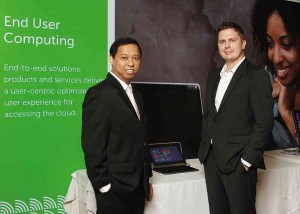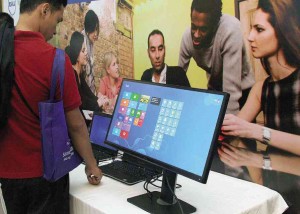Redefining the IT firm’s CIO as change agent
MANILA, Philippines—It used to be that the Information Technology Department was at the back of the office making sure that the systems were up and running. Got a virus? Can’t log on?
Today, it’s the go-to place that manages data and helps companies make life-changing decisions.
“IT is in a unique position in the company. IT can see end-to-end from sales, marketing, finance, supply chain. We added a responsibility to IT—to be a change agent in the company. At Dell, we’re shifting to a more strategic IT. That’s where IT not only handles technology but also helps with our business strategy. It can help the company drive innovation and, at the end of the day, improve bottom line results. The line between business and IT is now blurred. IT’s new role is expected to be more strategic,” says Justin Mennen, Dell’s regional Chief Information Officer for Asia-Pacific and Japan.
At the recent Dell Solutions Tour at the Hotel InterContinental, he came to Manila to spread the word on the CIO as a change agent.
Through the years, data or information and the IT that steers it have become vital organs in company. Hence, the chief information officer or CIO position was created to manage the processes in supporting the information flow in the organization. With all the data on hand, CIO can help in formulating strategic objectives for the company. He can analyze information, redesign workflow, determine and create new tools, remake the company’s facilities and systems and maximize the data resources.
“In the past, the work force wasn’t inclined to understand technology. Now everybody knows cloud and BYOD (bring your own device). It’s not an IT thing anymore. That is where expectations from IT have shifted. We can use technology to drive results,” says Mennen.
With his eye on the future, the CIO adds value by using technology to understand the business and applying it.
For example, IT can give a bird’s eye of company expenditure. “If you are a sales leader, here’s what it takes to run the business. It costs millions to maintain your system, mobiles, tablets, facilities and the people who operate it. (The IT can say) there is too many mobile phone in the org and it costs too much money. We decrease that and increase here, and we get better returns. That is where IT helps in the business versus taking orders and sitting down,” says Mennen.
“‘You can’t say, Mr. and Ms. Business User, give me your requirements and I’ll do what you ask me to do.’ That was IT of the past. Some companies are stuck in that. Our message is that IT organizations need to make a shift.”
He says Dell formed a business architecture team, composed of senior executives from different areas, it included IT. “They define the future of our company. In the past, IT would have never been in their discussion. Now it is an integral part of the strategy. We bring a different lens to it.”
Traditionally IT has maintained the organizations systems and infrastructure. “From a business perspective, they logged on and did what they needed to do and logged off. It’s always going to be important but we added things to it. We’ve moved from operations to consultative. We just don’t talk about how to keep things running, but to talk about the future.”
Mennen adds that IT can drive innovations in the company through business strategy.
When Dell envisioned its future in the next five years and the means to make it more profitable, the company looked into its various tasks (referred to as applications). It turned out that the company had too many apps with overlapping functions.
With the help of IT in analyzing the business processes and reengineering the infrastructure, Dell cut down its apps from 8,000 to 2,400, standardized its processes, reduced costs and increased productivity. The savings were re-invested in other business areas.
Mennen underscores that the IT has the responsibility to give full transparency. “That scares some IT organizations because if you provide full visibility, the business could use that information. ‘Why scrutinize?’ ’Why are you spending so much money here, etc.’ We welcome that at Dell. We want the business to understand where we are spending the money so we can drive the right changes in the company. It’s a mindset shift. IT used to be a black box. It has become close to the business. That is where strategy comes in and where industry trends are. IT has come close to the business to the point where we want to share our insights.”
Mennen has been touring the region to know more about the other Dell companies. On his job, he described, “We handle all strategic partnerships with business to make sure our global team understands what is happening. We are partnering with our key leaders. How in the region I can best align the team for success with our future? We are focused on our people.”
Mennen notes the strong team spirit and talent in the regional Dell workforce. “Loyalty is good and attrition is low. There are certain skill sets where they excel. There are opportunities for us to come up with.”
In the Philippines, Dell is strong in the enterprise market with servers, networking, software, and services. The business is focused on contact centers and BPO for customers in the US and Europe. Thus, Dell’s 1,600 employees require access and secure data quickly.
“The CIO’s role is critical for us to support our clients. He has to understand our client,” says Richard Teo, president of Dell Philippines. “For example, if I am a bank and I need to outsource my call center to Dell, we will take the services job. The bank has specific IT requirements which I may not be able to help. For them to connect and for us to run their contact center, we are going to need their technology. That is where we are going to be dependent on the CIO.”
He adds that in the light of competition, a BPO’s success lies in speedy and competent service. “The CIO has to come up with new tools and innovations so we can do the work for the customer more efficiently and more cost-effective and faster,” says Teo.
“When a call comes in, they listen to the customer’s issues, and help them. The system has to be stable and ready. The CIO ’s role is critical not only for smooth operations. We have to plan ahead as we grow. We have to make the CIO understand how we are growing, what areas we are growing so he can anticipate and plan for our growth.”
Teo notes the trend of BYOD in the workplace as employees prefer to use their smartphones and tablets. The CIO’s job is to help find solutions in helping the employees secure customer data without any risking confidentiality.
Teo adds that since Dell is involved in diverse industries, the CIO’s role is vital. “The needs of these clients are different. We depend on the CIO to help us design solutions to meet our customer’s need. Apart from keeping our systems stable so our employees can handle the existing businesses, we are going after new accounts and new clients. Each client will have his own requirements, be it security, data management. We need the CIO to help us formulate and work on the solution so we can respond to our client’s business needs.”

